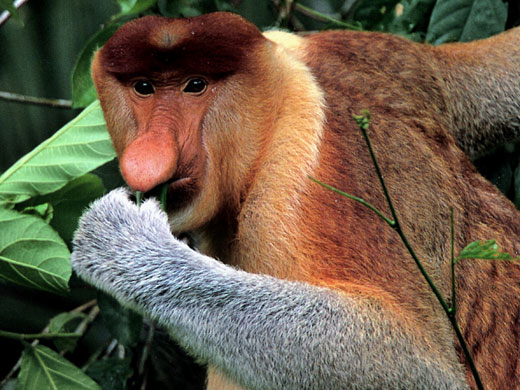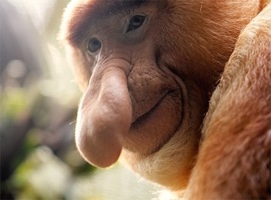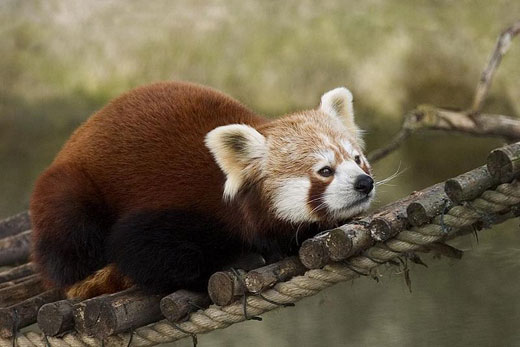Proboscis Monkey
Also known as the Monyet Belanda, Bangkatan, or even the Long-nosed Monkey, the Proboscis Monkey is an arboreal Old World monkey. The monkey is most well known for its very large nose as well as its reddish brown color. The nose is the first thing to be seen on this monkey and that is because it is unlike any other primate nose that you will see. The unique nose, measuring up to seven inches in length, is only seen on the males and is thought to have something to do with a mating ritual. The nose does more than attract mates, it also swells with blood when the animal is angry or upset and makes warning calls louder and much more intense than other species.

The Proboscis Monkey
The males of this species are much larger than the females with the males being as large as 72 centimeters in length while the females are smaller at just 60 centimeters. The males usually weigh about 53 pounds and the females usually weigh in at about 25 pounds. The size difference of the Proboscis Monkey is the largest of any primate species.
Habitat
The Proboscis Monkey can most often be found in Borneo’s mangrove forests, swamps, and even the lowland riparian forests. The primates are known to move easily between dry land and shallow water and they even swim in deep water. What makes these primates unusual is that they move about from island to island, and in doing so they are often seen walking upright in a single file line. These monkeys basically move from area to area as they see the need to meet feeding and shelter needs.
Diet

The Long-Nosed Proboscis Monkey
Despite their ability to remain in the canopies of the rainforest the monkeys are often found swimming and are therefore picked up by fishermen and kept as pets or even captured for their skins. Due to hunting and the loss of natural habitat, there are only about 7,000 of them left the world over. The species is listed as endangered on the International Union for the Conservation of Nature and Natural Resources’ red list. As a result, these monkeys should be protected and their habitat respected.
Proboscis Monkey Image Gallery





its amazing how many animals i do not know.this is to thank you this website what a privilege to able to know and learn much about nature
wow
keep them out of cages!
The Proboscis monkey is SO awesome I even picked it to do on my report they are so interesting and what’s cool is no one even knows about them!
I am very very happy Super,
it very super, any new natural picture please send to my e.mail
Love your pics. Too bad I couldn’t get clear shots of these monkeys the last time I went to Kalimantan. So, can I use your close-up pics of them? Tried to click on ‘contact us’ but wasn’t able to get through. :S
this monkey is so cute! i ust learned this website today
i have never seen such ugly animals
i love this pic…this animal is so interesting and we should protect them like we protect ourselves….
The monkey reminds me of Squidward from Spongebob! It’s so cute in its own way!
squidward in mammals version. hahahahaha, they are absolutely adorable..